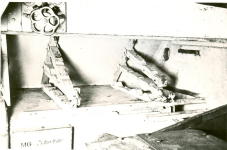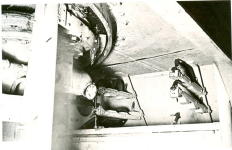

Volume 7, Issue 2
September, 20 2011
Introduction
Welcome to the twentieth issue of "Heavy Metal" -- the newsletter of the
Virginia Museum of Military Vehicles (VMMV.) Our mission is our motto -- by working to restore armored fighting vehicles, artillery, small arms, uniforms, and accoutrements of the US military and other countries, we hope to share the legacy of the sacrifice and courage of our fighting men and women with future generations of Americans. Located in Northern Virginia, our collection has grown to over 90 vehicles, starting out with the first US tank, the M 1917 through such legendary US vehicles as the M4A1 and M4A3 Sherman , M3A1 and M5A1 Stuart , M24 Chaffee , M3A1 Half-track , M36 Jackson and M3 Lee along with a few vehicles you might not know existed -- such as a prototype of the Rapid Deployment Force (RDF) tank.
Get to know your VMMV staff & vehicles
Get to know your VMMV staff & vehicles
In this section we introduce you to the people and armor of the Virginia Museum of Military Vehicles. We will chat with the VMMV staff, so that you can get to know the people who "keep 'em running" and work so hard behind the scenes. And also provide a behind-the-scenes look into the history of individual vehicles in the VMMV collection. In this, our twentieth newsletter, we highlight VMMV’s renovation of the earliest tank in our collection, the Six Ton Tank Model 1917. Although the restoration is only in its middle stages, we are so excited by our progress we wanted to provide you with a mid-term report.The Model 1917 tank was a copy of the French FT 17 tank designed by the famous car maker, Louis Renault. The Model 1917 tank is unique in that it was the world’s first tank with a fully rotating turret; previous tanks, such as the British “Mother” had their main armament in sponsons along the side of the hull, limiting their field of fire. The US tank is similar to, but not an exact duplicate of the French original, as the US had to convert the metric dimensions into English units.
VMMV tries to research each vehicle in its inventory, but we don’t know too much about our particular Model 1917, or even which US company made her. We acquired the vehicle approximately 15 years ago, rescuing it from a junkyard in Georgia where the hulk was being used as a yard ornament.
We brought the chassis up to VMMV and began a search for parts. Although some elements of the vehicle were in surprisingly good condition, the interior was basically scrap. Unfortunately you can’t go to the local NAPA auto parts store and find parts for a Model 1917 tank. We could have used a substitute engine since that is a very rare part and half of ours was missing, but that goes against the VMMV way of doing business….we restore to historical correctness.
Finally we hit the jackpot and found two engines. One was owned by a tractor collector in Indiana, the other was in a World War I ambulance. VMMV acquired both engines in 2009 and began the process of building one good engine from the remnants of the three. The gasoline powered, 4-cylinder, 42-hp engine was originally built by the Buda Engine Company based in Harvey, Illinois and is ready for installation after a year-long rebuild.
Since we now had an engine, the restoration of the interior could begin in earnest. Decades of rust had dissolved nuts and bolts into one mass of metal….the sound of hammers and wrenches filled the air as VMMV staff and volunteers sometimes spent a week just to loosen one critical suspension part. Cans of penetrating oil were also a critical element in our toolkit. We continue to make progress on bringing the Model 1917 back to life on a daily basis.
You might have had a chance to see the fully restored, operational engine during this year's Open House. But the chassis was moved to one of our machine bays because it was in pieces. Look for the Model 1917 tank to make a triumphant unveiling at a future Open House.
CLICK TO ENLARGE
LTC George S. Patton in front of a French Renault tank in France during WWI
From the Files of VMMV......
In this section, we will examine historical records and files on armor in World War II from the perspective of the British liaison office to the US War Department. Some of this correspondence discusses the capabilities and performance of US armor, other files are the British view of German armor, reflecting their understanding of the technical capabilities of the panzers they faced. VMMV is proud to be the custodian of these historical treasures and wishes to thank Mr. Peter Upton for donating his father's war time papers.
These files represent the actual understanding of the Allies of German armored fighting vehicles and represent a critical link between the myths and propaganda of both sides and the post-war technical exploitation. Some of the data may be incorrect or missing, represent critical intelligence that was unknown to the Allies at the time. You the reader are presented with the data in raw form to allow you to see the ground truth of Allied intelligence.
In our ninth installment, we will continue to examine several documents associated with the Panzerkampfwagen V or PzKw V…more commonly known as the “Panther.” Because of the large number of documents, we will break up the Panther file over several newsletters.
We have multiple, never-before-published exploitation photos of the interior of the PzKw V Panther. Enjoy a unique look inside of this storied vehicle.
CLICK TO ENLARGE
VMMV Acronym
The lexicon of armored vehicles is filling with a bewildering amount of acronyms. And at VMMV we have a few of our own. Here we will have the VMMV word of the day so you may better understand the conversations you might overhear at the museum.Torsion Bar….A torsion bar suspension system on a tank translates vertical wheel motion into a twisting of the torsion bar to provide spring resistance, rather than compressing a coil spring in order to provide the smoothest ride possible. The spring rate of the torsion bar is determined by its length, cross section and material. One end of the torsion bar is anchored to the vehicle’s chassis and the other end is attached to a suspension arm or axle. In general, torsion bar suspension systems take up less internal volume in a tank’s hull compared to a spring-type suspension, a critical factor in reducing a vehicle’s size and weight. Many famous tanks of WWII used a torsion bar suspension system, including Germany’s Panther and Tiger-tank families, the US M18 Hellcat, M24 Chaffee and M26 Pershing.
2011 VMMV Open House A Tremendous Success
Preparations for VMMV’s annual Open House begin the year before as discussions were held with living history groups, local jurisdictions and leaders of the American Wartime Museum. As the date neared, more and more exhibits and demonstrations filled up the time slots for both days. In the weeks prior, maintenance checks were performed on the vehicles, batteries tested, oil and coolant added where needed….Aden Field hummed with activity and anticipation. The week before the Open House, the engines were turned over and the vehicles rumbled to their parking positions.
Saturday, 20 August dawned hot and sunny—a glorious kickoff to the Open House. In the early morning hours VMMV staff and volunteers attended to last-minute tasks, the food stands stocked their shelves and then the public began to arrive. And boy, did they come!!!! Soon the parking lot was filled with hundreds of cars and people streamed into Aden Field.
Then, around 1030 in the morning, the distinctive whup-whup-whup of a UH-1 helicopter filled the air. VMMV staff and volunteers cleared a safety ring and the Huey swept over the arena and made a perfect landing. The gold letters of the US Customs and Border Protection Agency stood out against a gleaming black paint job. As the pilot shut down the engine and made the helicopter safe, the crowd moved forward and the UH-1 was surrounded by fans, young and old alike.
The battle arena was soon filled with the sound of scenario demonstrations and the roar of tank engines as the USMC Historical Company went thru its paces, culminating in the crowd favorites of tank guns firing and flamethrowers making things hot for everybody!!!
Around noon, the area was filled with the aroma of incredible taste treats. From the sweet corn picked by Mennonite ladies at 0430 that morning, to BBQ sandwiches….no one left hungry. And to cool off, the Ice Cream truck had a delicious cool and creamy desert. Chris and the Manassas Hard Times Café and Cue made a wonderful donation of their time and world-famous chili dogs—feeding famished VMMV staff and volunteers along with the living historians.
Sunday was a repeat smashing success, with some folks from Saturday returning for a second helping of fun and wonderment—VMMV style. Our final count of visitors for the two days was over 5,600…a new record!!!!! Thank you all for coming and we hope to see you again in 2012.
VMMV would like to thank all the folks who made the 2011 Open House such a great event. There are simply too many to list separately, but we want to highlight the magnificent contributions made by:
The Prince William County Sheriffs Office
Nokesville Volunteer Fire Department
American Helicopter
Prince William County K9
Boys Scouts of America, Troop 1636
WACBGMVT
Quantico Young Marines
The US Customs and Border Protection Agency
USMC Historical Company
Armor Modeling and Preservation Society
Prince William County Tourist Office
RC Tank Combat
VMMV volunteers, aka the “Gold Shirts”
Chris McNulty and the Manassas Hard Times Café and Cue (the official Chili and Pool parlor of VMMV.) http://www.hardtimes.com/location/detail.aspx LocationId=16In addition, because they add so much to the Open House, VMMV wants to give a big salute to all the living historians, re-enactors and exhibitors that helped make our 2011 event such a big success. VMMV greatly values the tremendous participation of all the living historians during the 2011 Open House, but if you don't see your group below we are sorry for the error; please contact Bruce at armornerd@comcast.net and we would be happy to add you to this listing:
East German Motorized Rifles
SS Fallschirmjager Battalion 600
North Staffordshire Regiment Living History Association
French Foreign Legion
7th U.S. Army Philippine Scouts
15th RECCE Canadian Army
11th Panzer Aufklarungs Abteilung
IR226 79th Infantry Division
154th Independent Spetsnaz Battalion
4th Infantry Division MP Battalion
US Cavalry 1940-42 display
2nd German Mountain Division
33 Guards Infantry Division of the Workers and Peasants Red Army
101st Airborne Division Long Range Reconnaissance Patrol
Angeli Obyeetse (Killer Angels) Workers and Peasants Red Army
Marine Corps Living History Group
51st Engineer Combat Battalion
Mark your calendars now for the next VMMV Open House in 2012 because the 2011 Open House continued a tradition of being bigger and better than ever. We have already started planning for 2012, you should too!
Michael Panchyshyn-Editor









